Panasonic Lumix 14-42mm f/3.5-5.6 G X ASPH. O.I.S Micro Four Thirds Le
Panasonic Lumix 14-42mm f/3.5-5.6 G X Lens Performance
At 14mm sharpness in the centre portion of the image is already excellent at maximum aperture and the clarity towards the edges of the frame isn't too far behind. These high levels of sharpness in the centre with good clarity towards the edges is maintained down to f/8.As is the case with many zoom lenses, overall sharpness levels drop off a little as the lens is zoomed in. Saying that sharpness is still excellent in the centre at maximum aperture at 25mm, and very good towards the edges of the frame. Stopping down a little improves the clarity in the centre a little, with peak quality being achieved at f/5.6.
At 42mm, overall sharpness is reduced, but at f/5.6 it still approaches excellent levels in the centre portion of the frame, with the quality towards the edges being fairly good. Peak quality across the frame is achieved at f/8, where the clarity of images is good across the frame.
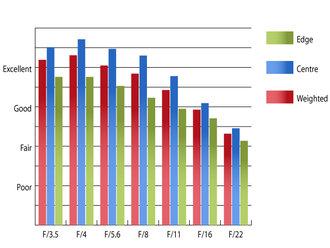 Resolution at 14mm | 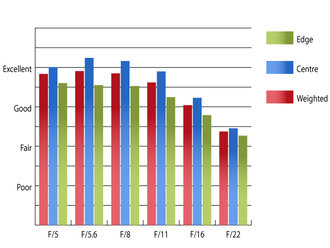 Resolution at 25mm | |
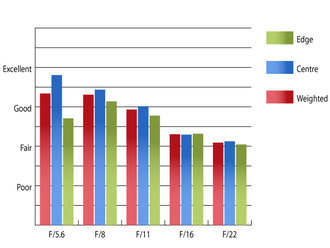 Resolution at 42mm | How to read our chartsThe blue column represents readings from the centre of the picture frame at the various apertures and the green is from the edges. Averaging them out gives the red weighted column.The scale on the left side is an indication of actual image resolution. The taller the column, the better the lens performance. Simple. For this review, the lens was tested on a Panasonic Lumix DMC-GX1 using Imatest. |
Chromatic aberrations are kept commendably low throughout much of the zoom range, peaking towards the edges of the frame at 14mm at apertures of f/4 and above.
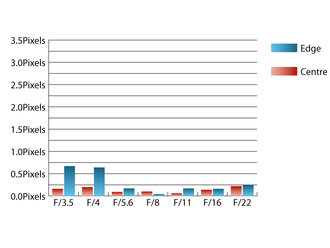 Chromatic aberration at 14mm | 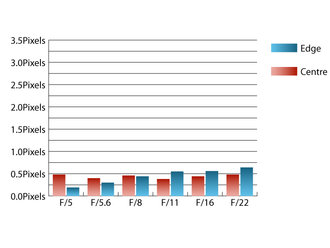 Chromatic aberration at 25mm | |
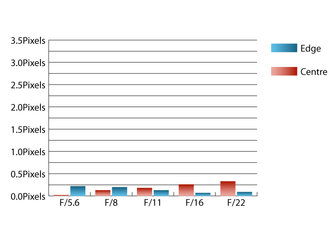 Chromatic aberration at 42mm | How to read our chartsChromatic aberration is the lens' inability to focus on the sensor or film all colours of visible light at the same point. Severe chromatic aberration gives a noticeable fringing or a halo effect around sharp edges within the picture. It can be cured in software.Apochromatic lenses have special lens elements (aspheric, extra-low dispersion etc) to minimize the problem, hence they usually cost more. For this review, the lens was tested on a Panasonic Lumix DMC-GX1 using Imatest. |
As falloff and distortion are corrected by the camera's image processing engine when shooting JPEGs, falloff and distortion will only be easily visible when working with RAW files. CA of 0.67 pixel widths was detected by Imatest here, which may start to become visible in high contrast areas towards the edges of the frame.
Falloff of illumination towards the corners is typical for a lens of this range, and shouldn't pose too many issues. At 14mm and f/3.5 the comers are 1.35 stops darker than the centre of the image and stopping down to f/5.6 results in visually uniform images. At 42mm, there is even less falloff to speak of. At f/5.6 the corners are only 0.7 stops darker than the image centre and stopping down to f/7.1 results in visually uniform illumination.
Distortions are quite strong at both ends of the zoom range for a lens covering this range. 4.02% barrel distortion is present at 14mm and 1.34% pincushion distortion at 42mm. The high distortion levels at 14mm may cause issues with critical applications where straight lines are paramount, such as photographing architecture. Luckily the distortion pattern is uniform across the frame, which should make it relatively straightforward to correct in editing software afterwards.
Add your message
Login required
Please login here or if you've not registered, you can register here. Registering is safe, quick and free.
Please login here or if you've not registered, you can register here. Registering is safe, quick and free.
photodo Stats
1102 lenses
428 MTF tests
74 in-depth photodo reviews
100+ users join each day
Help the lens community by reviewing or rating a lens today via our lens search
428 MTF tests
74 in-depth photodo reviews
100+ users join each day
Help the lens community by reviewing or rating a lens today via our lens search
Latest Lens Reviews
- Chinon 28mm f/2.8 Vintage Lens Review
- Canon EF 70-200mm f/4L IS II USM Lens Review
- Samyang AF 85mm f/1.4 EF Review
- Sigma 70mm f/2.8 DG Macro Art Review
- Samyang AF 24mm f/2.8 FE Review
- Meike 50mm f/1.7 Review
- Tamron 70-210mm f/4 Di VC USD Review
- Lensbaby Burnside 35mm f/2.8 Review
- Asahi Super Takumar 50mm f/1.4 Review
- Asahi Super-Multi-Coated Takumar 135mm f/3.5 Review
